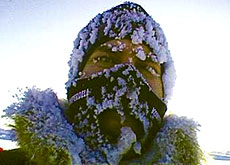Swiss researcher finds polar paradise

Scientist Sébastien Barrault has found his personal paradise in one of the most inhospitable places on earth – the Arctic Circle.
The softly spoken Swiss has decided to make the remote Norwegian Svalbard archipelago, with its remote natural beauty and unique lifestyle, his new home.
Svalbard, roughly one-and-a-half times the size of Switzerland, is subject to sudden storms and intense cold. Nature reigns supreme over man.
There are nearly as many polar bears as the roughly 2,500 people on islands, but Barrault says the bears normally do not disturb humans.
“Polar bears are fascinating and scary. If bears and humans respect each other’s territory, there are no problems,” said the 30-year-old researcher.
Nevertheless he always keeps a rifle close at hand. Bears, he explains, sometimes don’t know their boundaries.
Barrault, from Sion in canton Valais, is studying the properties of polar ice at Svalbard University.
Unique experience
“Living and working here is unique. There is something magic about this place: the contact with nature, the huge open spaces and the never-ending nights,” said Barrault, who has been living on the island of Spitsbergen since 2005.
Barrault’s first experience of the area was in January 2004, which he described as “mesmerising”. His planned six-month stay soon became a year.
“I wanted to experience the entire polar light cycle,” he explained.
Barrault returned to Switzerland only to be faced with few job openings that suited him. His mind was set on a quick return to the Norwegian archipelago, and opportunity soon came knocking at his door.
“My university professor contacted me and asked if I wanted to do a doctorate. I didn’t need to give the idea a second thought.”
Perfect town
Barrault lives with his partner Elin in Longyearbyen – at around 2,000 inhabitants the biggest settlement on the islands – in a quaint prefabricated house with all modern conveniences.
He says there is much to enjoy about life in the northernmost town in the world.
“This is a tax-free zone and work contracts are the same for everybody,” he said.
“There is no unemployment, no crime and no military presence. Doors are left unlocked and if you leave a bag somewhere, you’ll certainly find it again in exactly the same spot.”
It is therefore not surprising that the police force on the 62,000km² archipelago is made up of just five officers.
Bear necessities
But there are also some inconveniences. Apart from the cold, the inhabitants have to deal with occasional power outages, which could have serious consequences. Long blackouts mean the town has to be completely evacuated.
And sharing the same territory with polar bears means acting with care.
“One time I ended up alone at night without a rifle in an area where I had seen a bear two years earlier,” recounted Barrault.
“I thought about burying myself in the snow. It was a stupid idea because I remembered that bears could smell seals at a depth of one metre. After a very long 15 minutes, somebody came to get me.”
Warm heart
Barrault has had to adapt to the polar rhythm. But he says the lack of light between mid-December and the end of January brings out the best in people.
“People get together and life is more sociable. There is a special atmosphere,” he explained.
“The return of the light is unique, even though adapting to the daytime rhythm is hard and you tend to lose the notion of time.”
Barrault plans to take his arctic lifestyle a step further: “I would like to spend a year in an isolated hut hunting and setting traps for foxes, in true Svalbard tradition,” he said.
The researcher has no plans to return to Switzerland. Living close to a glacier called Tell, a Helvetia Valley and a mountain named Valais helps avoid homesickness, he jokes.
swissinfo, based on an Italian article by Luigi Jorio in Svalbard
Svalbard archipelago: 62,000km²
Around 2,500 inhabitants
Under Norwegian sovereignty since 1920
At the end of 2006 there were 2,086 Swiss living in Norway (1,241 with dual citizenship)
Like Switzerland, Norway is not part of the European Union but a member of the European Free Trade Association (with Iceland and Liechtenstein)
Sébastien Barrault was born in Sion, canton Valais, in 1976.
After completing his studies in mechanical engineering at the Federal Institute of Technology in Lausanne, he worked for a year at Geneva University Hospital in the osteopathy department.
In 2004 he travelled north to take a geophysics course at Svalbard University in Norway.
After a brief stay in Switzerland, he returned to Svalbard where he is currently doing research for his doctorate on the thermal properties of sea ice.
Svalbard consists of a group of islands in the Artic Ocean, north of mainland Europe. Three islands are inhabited: Spitsbergen, Bjørnøya and Hopen.
The largest settlement is Longyearbyen while the smallest, a Norwegian weather station in Hopen, has a population of four.
There are no roads linking the different settlements on the island. Modes of transportation include boats, planes, helicopters and snowmobiles.
According to the Treaty of Svalbard, you have the right to settle on the archipelago if you can find work.
With a population density of 0.4 people per km², Svalbard is one of the least-populated areas in the world.

In compliance with the JTI standards
More: SWI swissinfo.ch certified by the Journalism Trust Initiative












You can find an overview of ongoing debates with our journalists here . Please join us!
If you want to start a conversation about a topic raised in this article or want to report factual errors, email us at english@swissinfo.ch.